 |
Zenith Royal 50VK U.S.A. - 1963 |
|
|
|
Italiano |
||
|
Following the success of the first pocket radio, the TR-1, built and marketed in the United States by Regency in 1954, in the second half of the 1950s both the electronics manufacturing industries of the U.S. that other nations of the world mobilized to enter the new market that the use of semiconductors had opened. The Zenith company achieved great sales success with the Royal 500 series of pocket transistor radios and later with the smaller Royal 50 series, built from the late 1950s and early 1960s in the Zenith factory in Illinois. The Royal 50VK circuit was of the superheterodyne type using six gerrmanium transistors: 3 type PNP in the RF stages (121-234, 121-235, 121-236), and 3 NPN transistors in the audio stage (121-237, 121-238, 121-238) and a germanium signal diode X1. The variable capacitor C1 was still of the metal type with air insulation and reported the year and the week of construction (6434 = week from August 20 to August 26, 1962). The antenna was a flat ferrite rod on which the coil L1 was wound and the intermediate conversion frequency resonated at 455 kHz. The plastic cabinet was made in different colors (VK mean red color case) and the power supply was provided by two cheap 1.5V type AA (LR6) batteries that still allowed a good autonomy. Thanks to the 2 inch speaker (and 11 Ohm impedance) driven by the pair of NPN power transistors type 121-238, the sound was warm as in all Zenith receivers. The dimensions of the 50VK were: 2.5 x 4.25 x 1.25 inch, and the weight including the batteries was 0.5 lb. Historical cold war note: As in other radio receivers with Medium Wave reception built and marketed in the U.S.A. starting from 1951 until 1963, it can be noted that also in this Zenith the acronym CD (Conelrad) is impressed on the dial scale in correspondence with the two nuclear warning frequencies of 640 and 1240 kHz. (For more information follow this link). © IK3HIA 2007. |
|||
|
|
|||
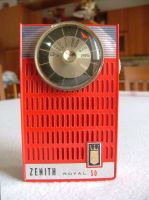 |
 |
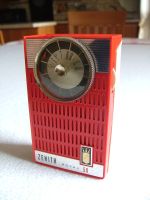 |
 |
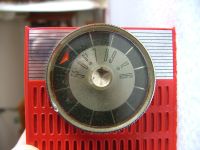 |
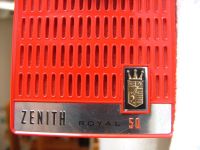 |
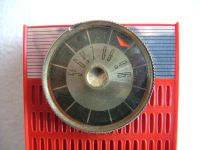 |
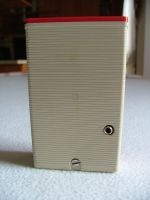 |
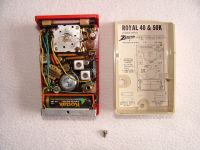 |
 |
 |
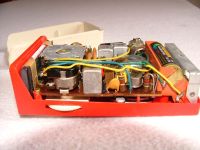 |
|
Below are more pictures and diagrams
|
|||
|
A seguito del successo della prima radio tascabile a transistor la TR-1 realizzata e commercializzata negli Stati Uniti dalla Regency nel 1954, nella seconda metà degli anni 50' sia le industrie produttrici di elettronica degli U.S.A. che delle altre nazioni del mondo si mobilitarono per inserirsi nel nuovo mercato che l'utilizzo dei semiconduttori aveva aperto. La ditta Zenith ottenne gran successo di vendite con la serie di radio a transistor tascabili Royal 500 e successivamente con la serie Royal 50 dalle dimensioni più contenute, costruita alla fine degli anni '50 e nei primi anni '60 nella fabbrica Zenith dell'Illinois. Il circuito Royal 50 era del tipo supereterodina che utilizzava sei transistor al germanio: 3 di tipo PNP negli stadi RF (121-234, 121-235, 121-236) e 3 transistor NPN nello stadio audio (121-237, 121-238, 121-238) e un diodo di segnale al germanio X1. Il condensatore variabile C1 era ancora del tipo metallico con isolamento ad aria e riportava l'anno e la settimana di costruzione (6434 = settimana dal 20 al 26 agosto 1962). L'antenna era una barra piatta di ferrite su cui era avvolta la bobina L1 e la frequenza di conversione intermedia risuonava a 455 kHz. Il mobiletto in plastica era costruito in differenti colori e l'alimentazione era fornita da due economiche batterie da 1,5 V del tipo AA (LR6) che permettevano comunque una discreta autonomia. Per merito dell'altoparlante da 2 pollici (e 11 Ohm di impedenza) pilotato dalla coppia di transistor NPN di potenza tipo 121-238, il suono era caldo come del resto in tutti i ricevitori della Zenith. Le dimensioni della 50VK erano: 11 x 7 x 3.5 cm, e il peso comprese le batterie era di 277 g.
Nota storica sulla guerra
fredda: © IK3HIA 2007. |
|||
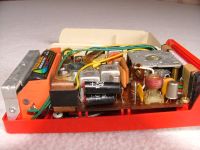 |
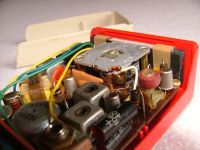 |
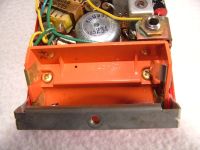 |
 |
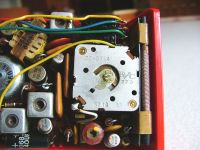 |
 |
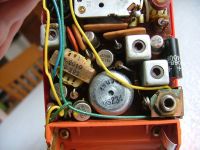 |
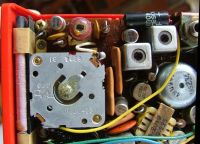 |
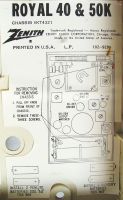 |
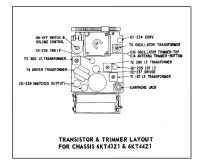 |
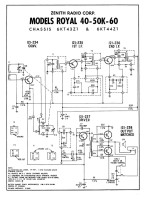 |
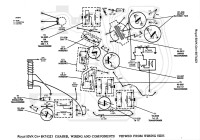 |
|
Return to top of
page
|
|||
| Back to: |
|
IK3HIA home page |
|
Zenith Radio page |
|
Transistor Radio page |
|
Transistor diagrams |